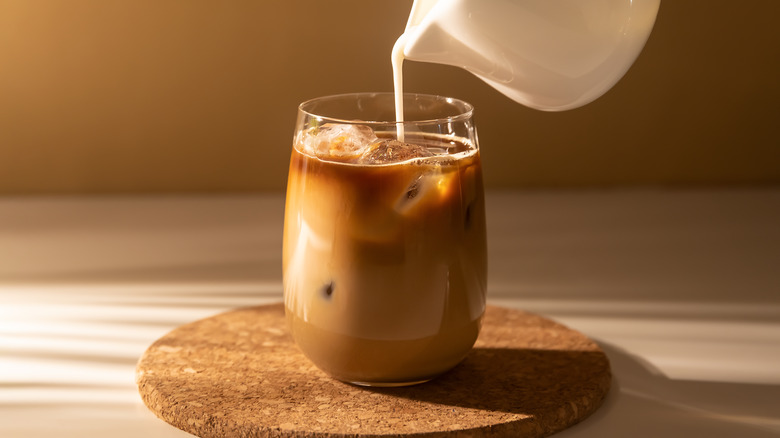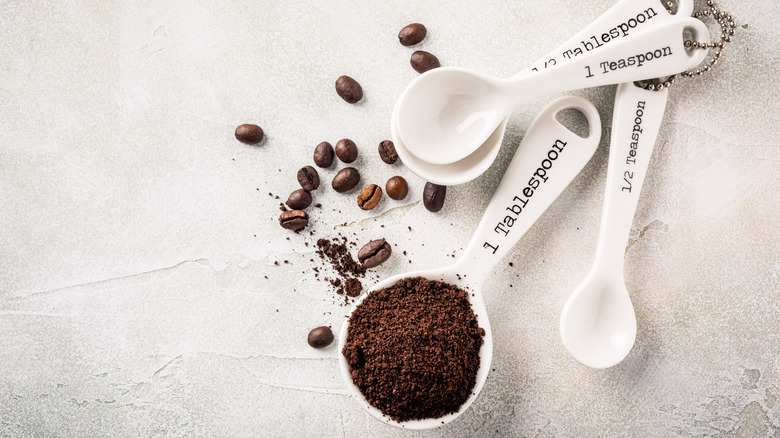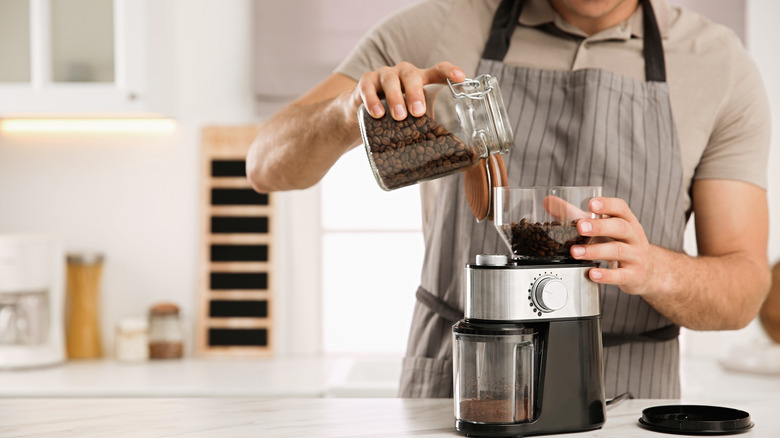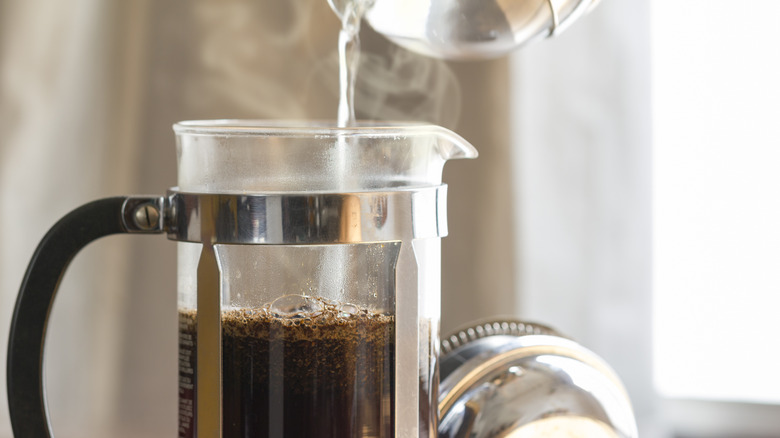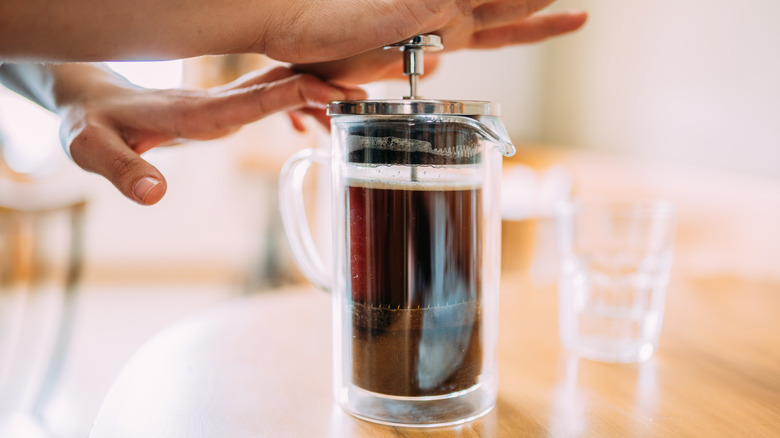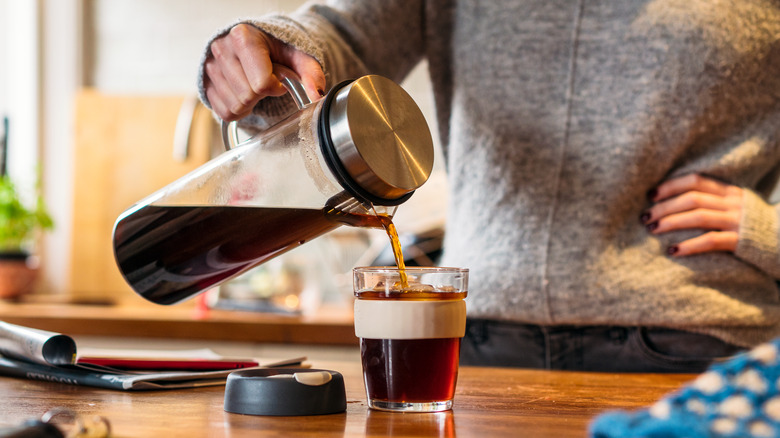How To Make Cold-Brew Iced Coffee Using A French Press
It's time to get to know your cold coffee types. Although it's similar in temperature to iced coffee, cold brew is more concentrated since it doesn't rely on ice to cool the beverage down. Beans are ground and steeped in cool water to extract their flavor and oils slowly, resulting in a bolder coffee containing more caffeine.
Unlike coffee made with hot water, which can take a few minutes for pour-over or seconds for an espresso, this process can take 12 to 24 hours for the grounds to infuse the water thoroughly. Starbucks allows its cold brews to steep for 20 hours. If you don't want to pay the markup for the same beans, brew some at home.
This process can be done with cold brew makers, which have fine mesh filters that prevent the grounds from being poured out with the coffee. These coffee makers generally retail for under $30 and allow you to store a batch of brewed coffee in the refrigerator to enjoy during the week, so you don't have to repeat this daily.
However, new equipment isn't necessary if you already have a French press. Similar in design, a French press coffee maker can create the perfect cold brew without finding room for another gadget. Its built-in mesh filter traps spent grounds to deliver a smooth, bold brew at home. Start this process the day before, and you won't be disappointed.
Measure the ground beans
The amount of coffee grounds used to make a cold brew coffee depends on just how strong you like it. The ratio is the same whether you are brewing hot or cold coffee — so just stick to your usual amount. This can be between one to two tablespoons of grounds per six ounces of water. Since cold brew is a bolder style of coffee, often drunk with a little milk or water to dilute it, a French press of cold brew will stretch further than traditional hot coffee.
To avoid grinding too much coffee, weigh the beans for accuracy. For each tablespoon of grounds needed, measure about 5 grams of beans. If you don't have a scale, roughly 39 beans are in a tablespoon of grounds or four tablespoons of whole beans. Different-sized French presses are available, but if you use the standard 34-ounce capacity, you'll need between ⅓ and ¾ cup of coffee beans, depending on your taste.
Freshly grind the coffee beans
For the best-tasting cold brew, start by grinding your beans fresh rather than using pre-ground. To slow down the extraction process, the beans should be coarsely ground, resembling the size of turbinado or raw sugar. A fine ground will produce a bitter taste and cloudy coffee.
You can use any variety of roast you prefer to make cold brew — light, medium, medium-dark, dark, or even flavored. Light roasts will have less oily beans and a lighter color. These beans will produce a more acidic coffee compared to the other end of the spectrum, but dark roasts are sometimes more bitter. Common dark roasts include French, Italian, and Viennese, but don't overlook volcanic blends like those from Sumatra, Java, or Hawaiin Kona. Light roast coffees tend to be a little less specific, so if you want to try one, see what your favorite coffee roaster offers and what they suggest. Just remember that cold brewing will produce a less acidic blend, so your light roast coffee may not be as flavorful as medium or darker roasts.
Add the ingredients to the French press
Remove the lid and plunger from the French press and add the desired ratio of coffee grounds to water on the bottom. Next, you'll need to slowly pour in cool water in two stages rather than all at once. Add about half of the water and then gently stir the grounds to ensure they are entirely soaked before adding the remainder. Otherwise, the grounds may float to the top and not incorporate fully, leading to a weaker cup of coffee.
Replace the top, but do not press down on the plunger. Allow the coffee to steep for at least 12 hours at room temperature, or store the carafe in the refrigerator overnight. Straining the coffee prematurely can leave it tasting too acidic, so be patient. By hour 18, it is bold and smooth. If the coffee maker is too tall with the plunger sticking out to properly store in your fridge, you can cover the top with cheesecloth or a paper coffee filter until it's time to filter the cold brew.
Press down on the plunger
Once the coffee has been steeped, slowly press down on the plunger to separate the grounds from the liquid. Don't be hasty! Really go slowly, or you risk the coffee exploding out of the mouth of your press, and some people say plunging quickly can result in a more bitter brew — though the science behind that seems dubious at best.
This will force the grounds to the bottom of the carafe, filtering the cold brew for you to enjoy. If you aren't planning on drinking all the coffee in one day, strain it into another resealable container, discarding or recycling the grounds. Instead of throwing the grounds in the trash, you can add the spent coffee to your garden mulch. The coffee's acidity will keep hydrangeas a bright blue hue and deter pests like slugs and snails from eating your veggies. Conversely, worms love coffee grounds, so they'll happily eat the grounds and create fertile soil in exchange.
How to enjoy cold brew
Once prepared, you can flavor cold brew coffee as you would any other choice. Due to its concentration, many cold brew drinkers prefer to dilute the coffee with a little splash of dairy or cold filtered water. Plus, adding a little milk to your coffee may even help to reduce inflammation (per Healthline). Of course, if that isn't your proverbial cup of tea, just enjoy it black or maybe with a touch of sweetener added.
Depending on your preference for strong coffee, this could be as much as a 50:50 ratio of cold brew to milk. Store the concentrated cold brew in the refrigerator and add your syrups, milk, or other flavorings before you enjoy a cup. Cold brew keeps in the fridge for two weeks, so you may consider making a large batch.

